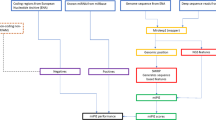Abstract
MicroRNAs (miRNAs) have been shown to play an important regulatory role in plants and animals. A large number of known and novel miRNAs can be uncovered from next-generation sequencing (NGS) experiments that measure the complement of a given cell’s small RNAs under various conditions. Here, we present an algorithm based on radial basis functions for the identification of potential miRNA precursor structures. Computationally assessing features of known human miRNA precursors, such as structural linearity, normalized minimum folding energy, and nucleotide pairing frequencies, this model robustly differentiates between miRNAs and other types of non-coding RNAs. Without relying on cross species conservation, the method also identifies non-conserved precursors and achieves high sensitivity. The presented method can be used routinely for the identification of known and novel miRNAs present in NGS experiments.




Similar content being viewed by others
References
Kawaji H, Nakamura M, Takahashi Y, Sandelin A, Katayama S, Fukuda S, Daub CO, Kai C, Kawai J, Yasuda J, Carninci P, Hayashizaki Y (2008) Hidden layers of human small RNAs. BMC Genomics 9:57–58
Kawaji H, Hayashizaki Y (2008) Exploration of small RNAs. PLOS Genet 4:e22
Enright AJ, Jogn B, Gaul U, Tuschl T, Sander S, Marks DS (2003) MicroRNA targets in Drosophila. Genome Biol 5:R1
Wang Y, Stricker HM, Gou D, Liu L (2007) MicroRNA: past and present. Front Biosci 12:2316–2329
Maziere P, Enright A (2007) Prediction of microRNA targets. Drug Discov Today 12(11–12):452–458
Brennecke J, Stark A, Russell RB, Cohen SM (2005) Principles of microRNA-target recognition. PLoS Biol 3(3):e85
Friedlander MR, Chen W, Adamidi C, Maaskola J, Einspanier R, Knespel S, Rajewsky N (2008) Discovering microRNAs from deep-sequencing data using miRDeep. Nat Biotechnol 26:407–415
Stark A, Kheradpour P, Parts L, Brennecke J, Hodges E, Hannon GJ, Kellis M (2007) Systematic discovery and characterization of fly microRNAs using 12 Drosophila genomes. Genome Res 17:1865–1879
Holt RA, Jones SJ (2008) The new paradigm of flow cell sequencing. Genome Res 18:839–846
Sheng Y, Engström PG, Lenhard B (2007) Mammalian microRNA prediction through a support vector machine model of sequence and structure. PLoS One 2:e946
Szafranski K, Megraw M, Reczko M, Hatzigeorgiou GH (2006) Support vector machine for predicting microRNA hairpins. In: Proceedings of the 2006 international conference on bioinformatics and computational biology, pp 270–276
Jiang P, Wu H, Wang W, Ma W, Sun X, Lu Z (2007) MiPred:classification of real and pseudo microRNA precursors using random forest prediction model with combined features. Nucleic Acids Res 35(Web Server issue): W339–W344
Burnside J, Ouyang M, Anderson A, Bernberg E, Lu C, Meyers B, Green P, Markis M, Isaacs G, Huang E, Morgan R (2008) Deep sequencing of chicken microRNAs. BMC Genomics 9:185
Hofacker IL (2003) Vienna RNA secondary structure server. Nucleic Acids Res 31(13):3429–3431
Griffiths-Jones S, Saini HK, van Dongen S, Enright AJ (2008) miRBase: tools for microRNA genomics. Nucleic Acids Res 36:D154–D158
Hubbard JP, Aken BL, Beal1 K, Ballester1 B, Caccamo M, Chen Y, Clarke L, Coates G, Cunningham F, Cutts T, Down T, Dyer SC, Fitzgerald S, Fernandez-Banet J, Graf S, Haider S, Hammond M, Herrero J, Holland R, Howe K, Howe K, Johnson N, Kahari A, Keefe D, Kokocinski F, Kulesha E, Lawson D, Longden I, Melsopp C, Megy K, Meidl P, Overduin B, Parker A, Prlic A, Rice S, Rios D, Schuster M, Sealy I, Severin J, Slater G, Smedley D, Spudich G, Trevanion S, Vilella A, Vogel J, White S, Wood M, Cox T, Curwen V, Durbin R, Fernandez-Suarez XM, Flicek P, Kasprzyk A, Proctor G, Searle S, Smith J, Ureta-Vidal A, Birney E (2007) Ensembl 2007. Nucleic Acids Res 33 (Database issue):D447–D453
Morgulis A, Coulouris G, Raytselis Y, Madden TL, Agarwala R, Schäffer AA (2008) Database indexing for production MegaBLAST searches. Bioinformatics 15:1757–1764
Acknowledgments
We would like to acknowledge all anonymous reviewers for their helpful comments and suggestions.
Author information
Authors and Affiliations
Corresponding author
Additional information
Dedicated to Professor Sandor Suhai on the occasion of his 65th birthday and published as part of the Suhai Festschrift Issue.
Electronic supplementary material
Below is the link to the electronic supplementary material.
Rights and permissions
About this article
Cite this article
Riback, J., Hatzigeorgiou, A.G. & Reczko, M. Computational classification of microRNAs in next-generation sequencing data. Theor Chem Acc 125, 637–642 (2010). https://doi.org/10.1007/s00214-009-0684-z
Received:
Accepted:
Published:
Issue Date:
DOI: https://doi.org/10.1007/s00214-009-0684-z




